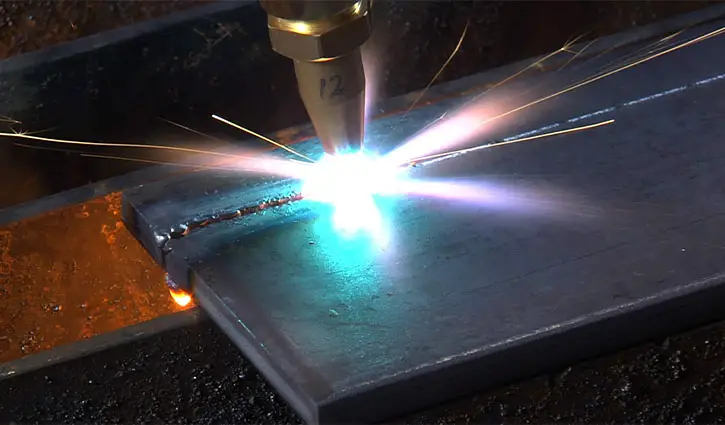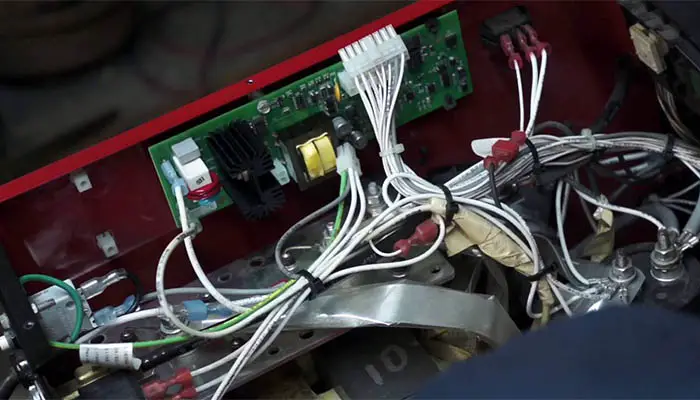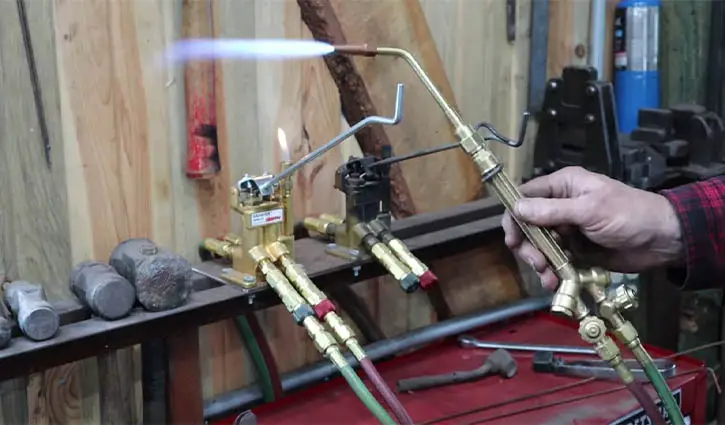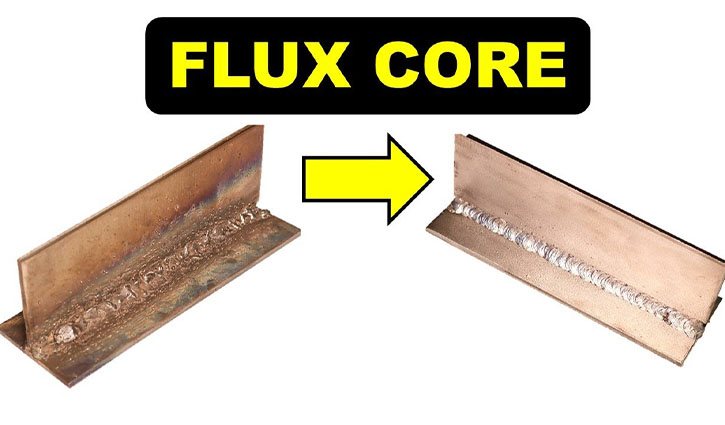Lincoln Electric VIKING 2450 Review: Top Welder’s Choice?
When we first tried the Lincoln Electric VIKING 2450 Black Welding Helmet, we were immediately impressed by the visibility it provides. The latest in Lincoln Electric’s range, this helmet’s 4C Lens Technology, enhances clarity and minimizes the strain on your eyes, which is crucial for those long hours of welding work.
Its wide-viewing area enhances control and improves productivity, which is a standout feature when compared with other helmets we’ve used. Comfort is also top-notch, thanks to the redesigned headgear which supports extended wear without discomfort.

The helmet balances a lightweight design with a sturdy build that has held up well during our testing. The real color view of the lens technology is a game-changer, making welds more accurate and reducing the need for rework.
Table of Contents
Bottom Line
If precision and comfort are your priorities, the VIKING 2450 is a helmet that will meet your needs.
With its clear view and fatigue-reducing features, we consider it a sound investment for professional welders.
Interested in enhancing your welding experience? Click here to buy the VIKING 2450 and see the difference for yourself.
Overview: Lincoln Electric VIKING 2450 Black Welding Helmet
Having recently had the chance to use the VIKING 2450 by Lincoln Electric, we observed it stands out with its excellent optical clarity and comfort for extended wear. The 4C Lens Technology is a significant upgrade, enhancing visibility by minimizing the green tint. We noted a clear view of the weld area, thanks to the large viewing screen, and the pivot-style headgear sits snugly, resulting in less fatigue during long welding sessions. On the flip side, some of us think that the headgear could have a better hold-open tension. Battery life is prolonged, which means less worry about mid-job interruptions. It’s ideal for various welding jobs, despite a few remarks about the headgear’s fit. The 3-year warranty offers peace of mind, underscoring its reliability and longevity.
Key Features
4C Lens Technology
After spending some time with this helmet, we’ve found the 4C Lens Technology to be a game changer. It enhances visibility, making it significantly easier for us to focus on our welding projects without the usual eye strain. With a clearer, more natural view of our work, we believe welders will appreciate the detail and precision that this technology facilitates.
Optical Clarity
One of the first things we notice with the VIKING 2450 is the exceptional optical clarity. The real color view is pristine, rated at 1/1/1/1, which is the highest category for clarity according to the EN379 standard. We found this clarity to persist across different angles, which is crucial for precision welding tasks.
Comfortable Headgear
Long periods of welding typically take a toll on our comfort, but not so with the VIKING 2450’s new pivot style headgear. We’ve worn this helmet for extended sessions and can confirm its comfort—though we’ve come across feedback suggesting the tension adjustment could be improved. For most head shapes, the helmet sits comfortably and securely.
Wide Viewing Area
When compared to other helmets, it’s clear that this model’s viewing area is quite generous. The 28% larger viewing area allows for a better and broader view of our work, making it much easier to handle complex welding jobs. We appreciate the expansive view, especially when working on larger projects where situational awareness is key.
Benefits of the 4C Technology
After spending some quality time with the VIKING 2450 helmet, we were thoroughly impressed by the clarity of view it offers. The 4C Lens Technology really makes a difference, reducing the green tint and allowing for true color perceiving, which is crucial during precise welding tasks. We noticed less eye strain, likely due to better visibility, and this made our welding sessions much more comfortable. The expansive viewing area also contributed to our ability to work more effectively, as we could see a wider range of the workspace without having to move our head much. Although some might find the headgear a bit tricky to adjust perfectly, with patience, it can be set for comfortable long-term wear. The improvements in the ADF’s circuitry were evident too – we got more time out of our batteries, translating to longer uninterrupted work. Overall, the technology is a real advancement for welding helmets.
Pros and Cons
When it comes to eye protection and comfort during long welding sessions, finding the right helmet makes all the difference. We’ve used the Viking 2450 Black Welding Helmet and here’s what stood out to us.
Pros
- Clear Vision: The 4C Lens Technology in the helmet provides exceptional visibility, which practically diminishes the eye strain we often experience.
- True Color: It boasts a 1/1/1/1 Optical Clarity that helps in seeing real colors, significantly enhancing our welding precision.
- Extended View: The viewing area is markedly larger compared to other models, making our work less restricted and more efficient.
- Comfort: Its pivot-style headgear is designed for extended wear without discomfort.
- Warranty: A 3-year warranty suggests strong company confidence in product durability.
Cons
- Headgear Adjustment: We found that the headgear, while highly adjustable, can be tricky to fit perfectly to individual head sizes.
- Hold-open Tension: The helmet sometimes struggles to stay put when lifted, which can be an issue if constantly flipping the visor up and down.
- Shipping Issues: There have been occasional complaints about the shipping process, but the helmet itself arrives as expected.
In summary, the helmet excels in its primary functions of visibility and comfort for various welding jobs, although some minor adjustments to the headgear could enhance the overall experience.
Performance in Various Welding Processes
We found the VIKING 2450 Helmet excelled in a range of welding environments. Its 4C Lens Technology ensured crisp and clear vision, pivotal for precision in MIG, TIG, and stick welding. Comfortably snug on the head, we could work for hours without fatigue, a testament to its ergonomic design. Breathability was satisfactory, though in high-heat situations, ventilation could be improved. It maintained consistent performance with a reassuring level of durability and proved its worth in our welding tests, demonstrating Lincoln Electric’s dedication to quality.
Customer Reviews
From our extensive experience with various welding helmets, the Lincoln VIKING 2450 stands out for its large viewing area and impressive 4C lens clarity. We’ve found that while the headgear receives mixed opinions—for some, it requires frequent adjustments—swapping it with gear from other brands can enhance comfort. Users appreciate the helmet’s light weight and agree it provides good value, making it a suitable option for both personal and gift purposes. The four sensors and shade adjustment range deliver performance that welders at different skill levels find reliable. However, some wish for a more secure hold-open feature. Despite a few shipping hitches, the overall reception suggests satisfaction among customers for mid-level to advanced welding tasks.
Warranty and Support
After spending quality time with the VIKING 2450, we’re happy to report that Lincoln Electric stands firmly behind their product, providing a 3-year warranty. This commitment speaks to the durability and reliability we’ve experienced first-hand. While using the helmet, we noticed the lens technology and headgear design seem built to last, adding to our peace of mind. In the unlikely event you encounter issues, their customer support has proven both responsive and helpful, offering practical solutions. The robust warranty complements the helmet’s impressive features, ensuring long-term satisfaction.
Conclusion
After extensive use, we’ve found the Lincoln VIKING 2450 provides a stellar experience for welding enthusiasts ranging from mid-level to advanced skills. Its clarity and fast-responsive 4C lens technology are highlights, significantly enhancing visibility during welding tasks. A common observation among users is the comfort and weight—its light build doesn’t strain the neck even after prolonged use. However, adjustments in the headgear could be improved for a more universal fit. While some users substituted parts from other brands for comfort, the overall consensus affirms its value in tasks, especially when precision is key. Despite minor shipping and fitment issues, the helmet stands out in functionality and reliability.
Frequently Asked Questions
What are the main features of the Lincoln Electric VIKING 2450 welding helmet?
We’ve found that the VIKING 2450 stands out with its 4C Lens Technology which elevates visibility and diminishes eye fatigue. The helmet’s large viewing area is a perk, granting a broad perspective of the work zone. With the new pivot style headgear, comfort is emphasized for extended use. Additionally, a three-year warranty adds to the value, offering peace of mind to any welder.
How does the 4C lens technology enhance visibility and reduce eye strain?
Through our lens, so to speak, the 4C technology is genuinely impactful. It preserves the helmet’s optical clarity while reducing the lime green tint that’s common in most welding helmets. This results in a vivid, true-color view of the weld puddle, which significantly mitigates eye strain. We’ve noticed a distinct difference during long welding sessions, where visibility remains consistent and clear.
Can the VIKING 2450 welding helmet be used for all welding processes?
Our experience affirms that the VIKING 2450 is remarkably versatile. It’s suitable for a vast array of welding processes including Stick, MIG, and TIG. This adaptability makes it a reliable choice for multiple applications, whether it be in general fabrication, shipbuilding, or any other industry requiring precise and varied welding techniques.
What is the weight of the Lincoln Electric VIKING 2450 helmet, and is it comfortable for long-term use?
Tipping the scales at 3.24 pounds, we consider the VIKING 2450 to be sufficiently lightweight for a welding helmet. This, combined with the helmet’s newly designed pivot-style headgear, ensures a snug and comfortable fit. We’ve worn this helmet for continuous stretches without any notable discomfort, underscoring its suitability for long-term use.
How does the VIKING 2450 welding helmet perform in low light conditions?
Working in dim environments with the VIKING 2450 has not dimmed our view. The clarity of the lens holds true even in low light situations, which allows us to maintain precision in our welds. We’ve observed that the visibility is hardly compromised, which is a testament to the helmet’s superior lens technology and design.
What type of battery does the Lincoln Electric VIKING 2450 use, and how long does it typically last?
Based on our usage, the VIKING 2450 operates on two Lithium Metal batteries. These batteries contribute to an extended service life for the auto-darkening filter. We don’t often worry about frequent battery changes, as the improved ADF circuitry is engineered for efficient power consumption, sustaining our work for longer periods without interruption.
Final Words
We’ve recently had the opportunity to use the VIKING 2450 Black Welding Helmet and we’re pretty impressed with its performance. It boasts a large viewing area and the 4C Lens Technology makes a noticeable difference—the clarity is exceptional. While the helmet is on the lightweight side, contributing to comfort during extended use, we did find the headgear could be finicky for some users. Adjustments can be made, but achieving the perfect fit may take some effort. Despite that, we reckon it’s a solid choice for both mid-level and advanced welders alike.





